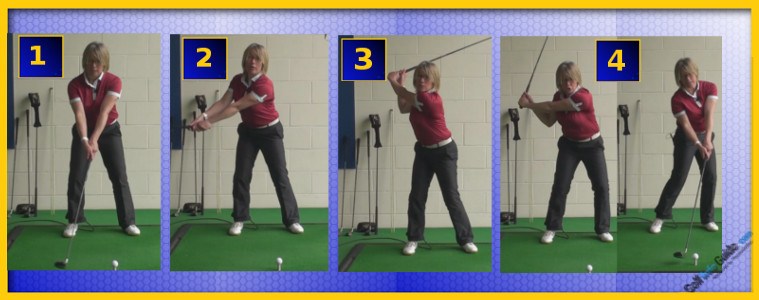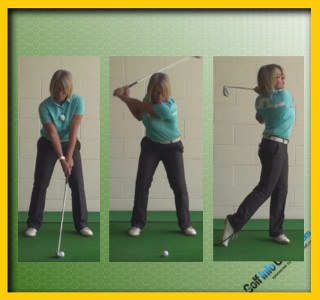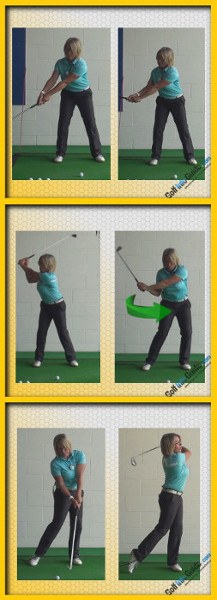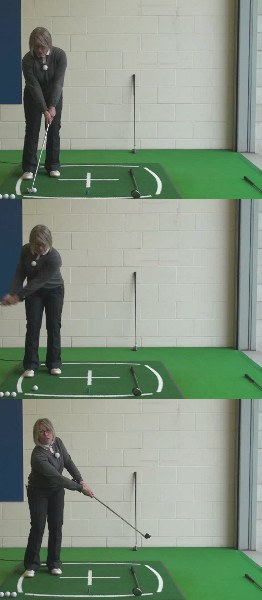A golfer who has good swing tempo will often be able to play more consistent golf than someone who swings with a less consistent or erratic tempo. Good players often look so smooth because of their good swing tempo.

A good golf swing tempo should adhere to a count of 1,2,3,4.
At your address position, as you start your swing, say the number one. At your half way back position say the number two. At the top of the backswing position say the number three, and at the impact position say the number four.
This will give you a backswing tempo three times longer than your downswing tempo. This creates a nice, stable, consistent turn in the backswing, fast acceleration into the impact position and provides plenty of consistency alongside plenty of power.
Work on this exercise during your practice routines on the driving range and then take the same swing tempo with you on to the golf course. Focus particularly hard on good swing tempo when you are under pressure and playing the last few holes.
Don't forget a good golf swing tempo can often hide a multitude of other technical golf swing faults.

Ways to Create the Best Golf Swing Tempo
The mechanics you use to make your golf swing play a big role in the kinds of shots you can produce. However, you can't play great golf on solid mechanics alone. To go along with those mechanics, you need to have an excellent tempo which you are able to repeat time after time. You can think of tempo as the glue which holds your golf swing together. Yes, you need solid mechanics, but those individual mechanics will quickly fall apart if you do not have a good tempo to go with them. The players who shoot the best scores at your local club are certainly those who have found the right tempo to pair with the fundamentals of their swing.
Unfortunately, tempo can be one of the most difficult things to teach in this game. It is hard to tell someone how to have a good tempo, because good tempo is different from player to player. Some golfers perform best with a slow tempo, some play better with a fast tempo, and many others fall somewhere in between. Finding the right tempo for your game is largely a personal pursuit, although there are some tips you can receive which will help to point you in the right direction.
In this article, we are going to offer some advice on how to improve the tempo in your golf swing. Again, it would be impossible for us to tell you exactly how quickly or slowly to swing the club, as you are your own unique golfer. The tips provided throughout this article will instead reveal some ways in which you can search for and locate your own ideal tempo. It is going to take some work to settle on a tempo which is right for your game, but that work will be rewarded with lower scores in the long run. Not only to players with a good tempo play better golf on average, but they also tend to play better under pressure. If you are serious about improving your performance on the course, working on your tempo is a smart choice.
While the tempo is usually associated with the full swing, your golf tempo actually extends from the driver all the way down through the putter. You need good tempo in your short game just as you need it in the long game, so any work you put in on your tempo should improve you all around the course. If you ever have a chance to watch golf on TV, you will notice that most of the best players in the world carry their tempo with them into every shot they hit. If a player swings quickly, they probably have a quick putting stroke as well. Or, if a player has a long, smooth swing, they tend to take their time on and around the greens. It is the mastery of their own personal tempo which has a lot to do with the success of some of the world's best golfers.
All of the instruction below is based on a right-handed golfer. If you happen to play left-handed, please take a moment to reverse the directions as necessary.

Why is Tempo So Important?
On the surface, it doesn't seem like tempo should be particularly important in the grand scheme of things. After all, if you use excellent swing mechanics, shouldn't your shots come off nicely regardless of your tempo? No – not necessarily. The tempo you use in your swing affects your timing, and golf is all about timing. Even a swing with perfect mechanics is not going to produce good results if the timing of the swing is off even marginally. Only when good mechanics come together with good timing can the ball be sent perfectly toward the target.
The importance of tempo comes down to the nature of the challenge you face when playing golf. In order to hit your target on a given golf shot, you need to place the club on the back of the ball with the club face at a very specific angle. If the face of the club is open or closed even a degree or two more than it should be, the ball is not going to head accurately toward the target. With so little margin for error, the timing of your release at the bottom of the swing needs to be nearly perfect. Since your body is rotating quickly to the left as you swing down, you need a timing mechanism to connect your body rotation with the swinging of the club itself. That timing is found in your tempo.
When a golfer or golf teacher talks about 'good tempo', they are really talking about the ability to repeat your tempo over and over again. There is no one right tempo, as it is certainly possible to play well with a slow swing, a fast swing, or anything in between. However, players who have good tempo are able to replicate their swing time after time at precisely the same speed. It doesn't matter what kind of tempo you prefer to use in your game. It only matters that you can use the same tempo every time, all day long.
While discussing the importance of tempo, it would be a mistake to ignore just how crucial this part of your game is when playing under pressure. You don't have to play at the highest levels of the game to experience pressure on the course – most golfers feel some degree of nerves in every round they play. Whether you are trying for a personal best score or trying to beat your friends in a casual match, you always want to play your best. To avoid having your swing break down when the heat it on, it helps to have a solid tempo to rely on. Executing the fine mechanics of your swing is harder when you are nervous, but your tempo can carry you through even if your execution is less than perfect.
Simply put, you are never going to play up to your potential without a good, reliable tempo in your swing. There is a lot to be said for taking time to practice the fundamentals of your swing, but those fundamentals will only get you so far. To make sure you have a complete game from top to bottom, you need to develop a beautiful tempo to add to those mechanics. Make the effort to work on your tempo and it is almost certain that you will become a better player.

Some Basic Steps
Working on your tempo can be frustrating, as you don't really have a specific target in mind for your efforts. When working on one of your swing mechanics, you can simply watch video of your swing to decide if you are on the right track. By comparing an old swing video to a new video, you can check out the progress you have made. While that might work a little bit for tempo practice, you aren't going to see your tempo as much as you are going to feel it. A subtle tempo change won't really appear on video, but your swing will feel dramatically different.
Despite the elusive nature of tempo improvements, you need to dedicate yourself to this point just the same. Fortunately, there are some steps you can take toward better tempo which will help you move toward the consistency you need to play your best. One of the things you can do to make progress toward a better tempo is simply to play more golf. Through experience, you will get better and better at swinging the club with the same pace every time.
While players on the professional tours obviously have plenty of talent, they also have the advantage of experience and repetition in this area. Pro golfers play or practice nearly every day, meaning they have plenty of opportunities to dial in their tempos just right. While you probably can't keep up that kind of schedule for your own game, you can make an effort to at least get out to the range more frequently. If you try to visit the driving range at least once per week, for example, you should see your tempo gradually become more and more consistent.
In addition to playing more frequently, another basic step toward better tempo is to avoid the temptation to hit the ball as hard as you can on every swing. If there is one thing that most amateur golfers have in common, it is the desire to maximize distance at any cost. Most golfers love to swing hard in the hopes of catching the ball right on the sweet spot for a monster drive or towering iron shot. While there is nothing wrong with distance, obsessing over this one part of the game can cost you in the tempo department.
It is hard to maintain a good tempo when you are swinging flat out at all times. Rather than going for max distance, turn your swing down and think more about control than power. This line of thinking runs against what most amateurs try to do with their games, but emphasizing control over power will do wonders for your tempo. No longer trying to swing as hard as possible, you will be free to settle into a nice rhythm which produces the same shot time after time. Believe it or not, this is the way most professional golfers play the game. Even though they still hit the ball great distances, most pros are simply trying to control the club as they swing. Pros know what amateurs seem to forget – golf is a target game, and controlling your ball is the only way to post low scores.
The two basics steps included in this section – playing more golf and swinging softer – can go a long way toward creating a reliable tempo. There is a tendency in the game of golf to overcomplicate the steps needed to work toward improvement, so we have kept things intentionally simple in this section of the article. Rather than crowding your mind with an endless string of swing thoughts which will only serve to confuse you, the better option is to keep the game as simple as possible. Get out to the range to practice more often, and when you do, work on hitting shots with a soft swing. Follow the advice in that previous sentence and your game is going to improve.

Staying In Tempo on the Course
If you spend any amount of time hanging around your local golf course, you have certainly heard players complaining about their inability to play as well on the course as they do on the range. This is a complaint that is as old as the game itself – nearly every amateur golfer feels they swing better on the range in practice than they ever do when playing a round of golf. While that isn't always as true as golfers would like to believe, there is some merit to this lament. For many amateur golfers, the shots they hit on the practice range never quite translate out to the course.
So what happens? Why is it so hard to take your game from the driving range out to the course? Usually, it comes down to tempo. On the range, there is nothing on the line – you aren't keeping score, you don't have a friendly wager with your buddies, and there is usually no one watching you swing. Under those conditions, it is easy to stay in your natural tempo. The story changes on the course, however. Suddenly, you are more concerned about the outcome of your shots, and you get nervous. That nervousness causes you to rush through your tempo, and your swing suffers as a result. If you are going to be able to play as well on the course as you do on the range, you need to find a way to keep your tempo consistent across the board.
The tips below should help you keep your tempo in line even after making the walk from the driving range to the first tee.
- A pre-shot deep breath. One of the best things you can do for your tempo on the course is to take a deep breath before you swing. That might sound simple, and it is, but it is effective. Taking a deep breath will require you to slow down for a moment, which is something you would not do otherwise. When nervous, it is a natural reaction to speed everything up, including the swing itself. Adding a deep breath to your pre-shot routine can reverse the pattern of moving quickly, and hopefully your swing will be slower as a result.
- Avoid watching other golfers swing. When playing in a group with other players, it is only natural to watch them swing as the round moves along. However, the simple act of watching the other players in your group hit their shots can actually hurt your ability to stay in tempo. To avoid watching their swings while still helping them track their shots, try staring down at the ball as it rests on the ground. Once the ball is sent into the distance, you can look up and follow its trajectory. This plan will allow you to be a good playing partner without having to risk losing your own tempo through watching others make their swings.
- Pick realistic clubs. This is a point we touched on earlier, but it bears repeating with regard to staying in tempo during your rounds. If you pick clubs based on your maximum possible distance, you are always going to be swinging at full effort while on the course. This is a sure way to lose your tempo. Instead, always give yourself a little bit of margin for error. For instance, rather than hitting a full eight iron for an approach shot, try hitting a softer seven iron. Using the longer club will help you still reach the target if you miss-hit the shot slightly, and you won't have to come out of your tempo to swing at 100% effort. Pro golfers frequently use more club than necessary in order to stay within a comfortable tempo, and you should consider doing the same.
The skill of taking your swing from the driving range to the course is something that will largely come with experience, but you can use the tips above to speed up the process. It is certainly frustrating to fail to play as well on the course as you do on the range, but this is a problem that can be corrected. Think carefully about what is changing in your swing when you step onto the course and work to eliminate those changes until your range and course swings are identical.

Tempo in the Short Game
As was mentioned in the introduction, it is important to have great tempo in your short game. You might not be trying to hit the ball 250 or 300 when chipping and putting, but you do need to be extremely accurate – with both your direction and your distance control. Great tempo can help you to be accurate, so finding a way to repeat your tempo over and over again is essential to your performance on and around the greens.
To make sure your short game isn't left behind as you make progress on your full swing tempo, please review the following tips.
- Focus on grip pressure. It is difficult to have a reliable tempo in your short game when you squeeze the club tightly. There is no need to hold onto the grip of your putter or wedge tightly while playing short game shots, as the club isn't moving quickly enough to come out of your hands. At address, relax your hands and use the big muscles in your back and shoulders to move the club back and through. Countless amateur players hold on too tightly when playing short shots, which is why poor putting and chipping is common in amateur golf. During your next short game practice session, pay attention to grip pressure and you should see your tempo –and your results – improve.
- Perfect speed. Rather than trying to jam the ball in the back of the hole, focus instead on using perfect speed to leave the ball right next to the cup if it doesn't fall in. Many golfers think they need to be aggressive with their short shots if they are going to be successful. Unfortunately, the aggressive way of thinking on and around the greens usually doesn't pay off. To stay in your tempo and to get down in two shots, place a premium on controlling your distance.
- Take one practice swing. You don't want to slow down your group my making four or five practice swings prior to each short shot, but using one practice swing to dial in your tempo is a good idea. Walk up to the ball with your club in hand and make one practice swing or stroke while looking up at the hole. As you make this practice motion, think only about your tempo. After the practice swing is complete, step in and hit the shot without wasting much time.
No one is going to be able to tell you exactly what tempo is going to be best for your game. The only way to discover your ideal tempo is to get out there and find it for yourself. Hopefully, the information offered above will help you zero in on your tempo sooner rather than later. With a great tempo installed in your game, you should be able to play at a higher level in the near future – and your game should hold up better under pressure as well. Players with great tempo usually rise to the top in most golf competitions, so be ready for some of your best results once your tempo work is complete. Good luck!






